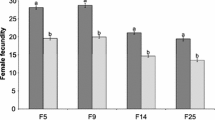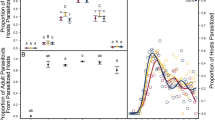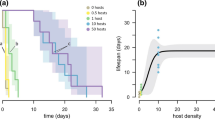Summary
Demographic parameters for the Mediterranean fruit fly reared on each of twenty four different hosts from sixteen different plant families are reported. These include cohort parameters of development, survival, pupal sizc, and fecundity as well as population parameters such as intrinsic rate of population increase (r) and mean generation time. Major findings include the following: i) no consistent quantitative relationships existed between r and its chief demographic determinants such as preadult developmental time and adult fecundity; and ii) few correlations existed among the cohort life history parameters themselves. The principle conclusion is that the medfly is a successful generalist frugivore because of its developmental ability to offset the effect of the value for a host-specific trait that tends to lower r with one that tends to increase r, the net result of which is to maintain a relatively high r.
Similar content being viewed by others
References
Abasa RO (1972) The Mediterranean fruit fly, Ceratitis capitata Wied. laboratory investigations of its reproductive behaviour in Coffea arabica in Kenya E Afr Agric For J 37:181–184
Back EA, Pemberton CE (1918) The Mediterranean fruit fly in Hawaii. USDA Bull No. 536 pp 1–118
Barbosa P, Waldvogel M, Martinat P, Douglass LW (1983) Developmental and reproductive performance of the gypsy moth, Lymantria dispar (L.) (Lepidoptera: Lymantriidae), on selected hosts common to mid-atlantic and southern forests. Environ Entomol 12:1858–1862
Bateman MA (1972) Ecology of fruit flies. Annu Rev Entomol 17:493–518
Bozzini A, de Murtas ID (1975) Insect pest control and insect breeding. Redia 56:473–487
Bush GL (1969) Sympatric host race formation and speciation in frugivorous flies of the genus Rhagoletis (Diptera: Tephritidae). Evolution 23:237–251
Bush GL (1975) Modes of animal speciation. Annu Rev Ecol Syst 6:339–364
Carey JR (1982) Demography and population dynamics of the Mediterranean fruit fly. Ecol Model 16:125–150
Carey JR (1984) Host-specific demographic studies of the Mediterranean fruit fly Ceratitis capitata. Ecol Entomol 9:261–270
Cates RG (1980) Feeding patterns of monophagous, oligophagous, and polyphagous insect herbivores: the effect of resource abundance and plant chemistry. Oecologia (Berlin) 46:22–31
Cates RG (1981) Host plant predictability and the feeding patterns of monophagous, oligophagous, and polyphagous, insect herbivores. Oecologia (Berlin) 48:319–326
Chew FS (1975) Coevolution of pierid butterflies and their cruciferous foodplants. I. The relative quality of available resources. Oecologia (Berlin), 20:117–128
Chiang CL (1984) The life table and its application. Robert E. Krieger Pub Co. Malabar Florida
Christenson LD, Foote RH (1960) Biology of fruit flies. Annu Rev Entomol 5:171–192
Dethier VG (1980) Evolution of receptor sensitivity to secondary plant substances with special reference to deterrents. Am Natur 225:46–66
Dowell RV, Steinberg B (1979) Development and survival of immature citrus blackfly (Homoptera: Aleyrodidae) on twenty-three plant species. Ann Entomol Soc Am 72:721–724
Ehrlich PR, Raven PH (1964) Butterflies and plants: a study in coevolution. Evolution 18:586–608
Fox LR, Morrow PA (1981) Specialization: species property or local phenomenon? Science 211:887–893
Futuyma DJ (1983) Selective factors in the evolution of host choice by phytophagous insects. In: Ahmad S (ed), Herbivorous insects: host-seeking behavior and mechanisms. Academic Press New York, pp 227–224
Huettel MD, Bush GL (1972) The genetics of host selection and its bearing on sympatric speciation in Procecidochares (Diptera: Tephritidae). Entomol Exper Appl 15:465–480
Jennings DL (1979) Raspberries and blackberries. In: Simmonds NW (ed) Evolution of crop plants. Longman, London-New York, pp 251–254
Krainacker DA (1986) Demography of the Mediterranean fruit fly: larval host effects. MS Thesis, Univ California p 360
Lewontin RC (1965) Selection for colonizing species. In: Baker HG, Stebbins GL (eds) Academic Press, New York pp 77–91
Mourikis PA (1965) Data concerning the development of the immature stages of the Mediterranean fruit fly (Ceratitis capitata (Wiedemann) (Diptera: Trypetidae)) on different host-fruits and on artificial media under laboratory conditions Ann Inst Phytopath Benaki 7:59–105
Nakagawa S, Prokopy RJ, Wong TTY, Ziegler JR, Mitchell SM, Urago T, Harris EJ (1978) Visual orientation of Ceratitis capitata flies to fruit models. Entomol Exper Appl 24:193–198
Prokopy RJ, McDonald PT, Wong TTY (1984) Inter-population variation among Ceratitis capitata flies in host acceptance patern. Entomol Exper Appl 35:65–69
Rausher MD (1979) Larval habitat suitability and oviposition preference in three related butterflies. Ecology 60:503–511
Rivnay E (1950) The Mediterranean fruit fly in Israel. Bull Entomol Res 31:321–341
Rossler Y (1975) Reproductive differences between laboratory reared and field collected populations of the Mediterranean fruit fly, Ceratitis capitata. Ann Entomol Soc Am 68:987–991
Sampson JA (1980) Tropical fruits. Longman London-New York
Sanders W (1968) Die Eiablagehandlung der Mittelmeerfruchtfliege Ceratitis capitata Wied. Ihre Abhängigkeit von Farbe und Gliederung des Umfeldes Z Tierpsychol 25:1–21
Scriber JM (1982) Food plants and speciation in the Papilio glaucus group. In: Visser JH, Minks AK (eds) Proceedings of the 5th International Symposium on Insect Plant Relationships, PUDOC, Wageningen pp 307–314
Scriber JM (1983) Evolution of feeding specialization, physiological efficiency, and host races in selected Papilionidae and Saturniidae. In: Denno RF, McClure MS (eds) Variable Plants and Herbivores in Natural and Managed Systems. Academic Press, New York-London pp 373–412
Scriber JM, Feeney PP (1979) Growth of herbivorous caterpillars in relation to feeding specialization and to the growth form of their food plants. Ecology 60:829–850
Shoukry A, Hafez M (1979) Studies on the biology of the Mediterranean fruit fly Ceratitis capitata. Entomol Exp Appl 26:33–39
Smiley JT (1978) Plant chemistry and the evolution of host specificity: new evidence from Heliconius and Passiflora. Science 201:745–747
Wiklund C (1975) The evolutionary relationship between adult oviposition preferences and larval host plant range in Papilio machaon. Oecologia (Berlin) 18:185–197
Wiklund C (1982) Generalist versus specialist utilization of host plants among butterflies. In: Visser JH, Minks AK (eds) Proceedings of the 5th International Symposium on Insect Plant Relationships, PUDOC, Wageningen pp 181–192
Wong TTY, Mishimoto JI, Mochizuki N (1983) Infestation patterns of Mediterranean fruit fly and the oriental fruit fly (Diptera: Tephritidae) in the Kula area of Maui, Hawaii. Environ Entomol 12:1021–1039
Wood TK, Guttman SI (1981) The role of host plants in the speciation of treehoppers: an example from the Enchenopa binotata complex. In: Denno RF, Dingle H (eds) Insect life history patterns: habitat and geographic variation. Springer, Berlin Heidelberg New York pp 57–74
Zar JH (1974) Biostatistical analysis. Prentice-Hall, Englewood Cliffs, NJ
Author information
Authors and Affiliations
Rights and permissions
About this article
Cite this article
Krainacker, D.A., Carey, J.R. & Vargas, R.I. Effect of larval host on life history traits of the mediterranean fruit fly, Ceratitis capitata . Oecologia 73, 583–590 (1987). https://doi.org/10.1007/BF00379420
Received:
Issue Date:
DOI: https://doi.org/10.1007/BF00379420




